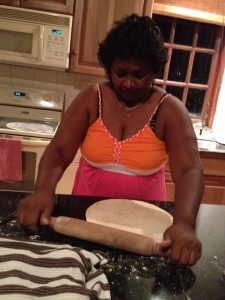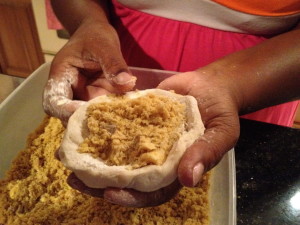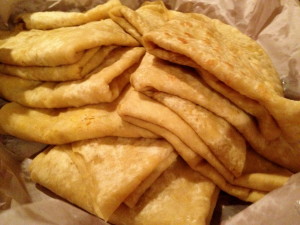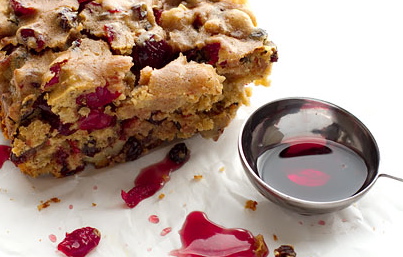Every once in a while I like to showcase a piece of writing or a recipe that I have really enjoyed. Today, I am honored to be able to share this sweet story written by Ya-Roo Yang.
__
Ya-Roo Yang is a New York City based food writer. Her work has appeared in The New York Times, Edible Queens and AM New York. She is currently working on a new food blog that lists the five best eats in New York City. Ya-Roo lives in the East Village with her corgi who enjoys food as much as she does.
___
When my boyfriend Brad caught the surfing bug, I knew I would have to spend part of our vacation time in small remote beach towns. Although I would have preferred urban metropolis that came fully equipped with farmer’s markets, high end chocolatiers and Michelin starred culinary temples; over the years we’ve managed to make good compromises between his surfing and my food obsessions. I loafed around pintxos bars in Saint Sebastian while he paddled in the waves, and feasted on the most exquisite grilled sardines on the sunny beaches of Portugal. Nonetheless, when he mentioned a surfing trip to Tobago, I was less than enthusiastic.
.
If given the choice, I would have picked the larger island of Trinadad over Tobago, the shark and bake at Maracas beach is supposedly a gastronomic “must”, not to mention shopping in the colorful markets. Tobago, according to Wikipedia, is mostly known for its tourism (sub-title: massive all inclusive resorts with lots of intoxicated people and soulless food); and ecological hotspot (translate: unfamiliar but deadly looking buzzing insects and crawling creatures that somehow manages to invade your hotel room despite layers of insect repellent, incense and electronic insect zappers).
Topping it off, the trip did not get off to the greatest start. As New Yorkers, we were spoiled on being able to get whatever food whenever we want. Craving Pizza at 2am NYC time? No problem! Lunch at 3pm Tobago time? No way! Lunch places are either pulling down the shutters or scraping out the empty food trays. The six hours morning flight had deposited us on to the small island tired and famished with not much in our stomachs except the standard airline issued peanuts. As I became progressively cranky with hunger, we decided to head to our hotel and see if our concierge has any recommendations. Twenty minutes later, sitting in a slowly moving taxi, I realized that the hotel Brad picked is situated on a remote part of the island. It is close to a surfing bech but away from any semblance of civilization, and what we thought was a room, turned out to be a house on top of a steep hill.
.
“Oh Boy,” Tamica, our hotel manager, sighed, when she heard that we haven’t had lunch. With her hair tightly pulled back in a bun, black suit and stockings in the stiflingly hot weather, Tamica looks more like a Sunday school teacher than a hotel manager. ‘You all should have stopped for groceries,” she said sternly shaking her head. Nonetheless, she promised to find what she could in the hotel’s kitchen and send it up to our house.
If I dislike hotel food, and I really dislike room service food. Even in the best of establishments where there are a zillion stars and diamonds trailing their names, room service fares are usually expensive insults to the ingredients they are made from. Most dishes either arrived tepid or ice cold, sometimes both. Soups tend to be covered by with a thick layer of curdled cream on the surface. Sandwiches made with crusty dry bread with meats that are unremarkable in every way except how bad it was prepared. If cheese is in anyway used in the preparation, it can be identified in the form of a greasy rubbery mess.
.
Under the normal circumstances, I would have waited until I could find something better than room service food to eat. Unfortunately by that time, the monster of hunger had won the match against better judgment and threw in a sprinkle of desperation. We went to our house, showered and tried to think optimistically about the impending room service lunch.
.
Half an hour later, a car drove up the small path along the house, delivering a round tray with a covered plate. We lifted the tray covers to find a large roti folded in quarters along side a generous bowl of steaming yellow curry that had pieces of firm white fish and chunks of tender potatoes. Sitting on the side of the bowel, was a carefully wrapped small dish of brownish green pickled mango. I tore off a piece of the warm soft roti, and a dusting of crushed chickpeas came tumbling out into the curry. The crushed chickpea gave the curry an added texture and the combination was exceedingly delicious. Pretty soon, the yellow colored sauce was running down both our hands as Brad and I mopped up the last bits of fish curry with roti.
I’ve eaten roti before this. On a trip to India some years ago, they were part of every meal during my stay in Delhi. I would watch them puffed up like balloons while being turned from side to side on the kitchen stove before they were flattened and placed in disk shaped metal containers. But, the traditional Indian version was more like unassuming flat breads made with wheat than the white flour version made in Tobago and the once I had in India certainly didn’t have any chickpeas in them.
.
After lunch, I called Tamica and asked her about the roti and was told in her typical terse manner that they can be found at any grocery store or supermarket in town. Since we needed groceries for the house anyway, we decided to stroll to the little village down the hill at Pleasant Prospect. While Brad went to look for his surfing instructor, I popped into the grocery store to fill the fridge.
With strips of fluorescent lights and low shelves, the grocery store at Pleasant Prospect seemed more like an urban bodega than a full fledge grocery. Mrs. Jennings, the thin bird like shop owner told me while she doesn’t carry roti, there is a woman in the village who will make them to order and that she would arrange to have some made for me if I return to the store tomorrow. That was when Brad walked in with his surf instructor.
George, the local surfing instructor and one person surf board renter, is a tall lean Rastafarian with dreadlocks hanging to the middle of his back.
“Oh you must be talking about Cynthia,” he exclaimed, having caught the tail end of the conversation. “She is a good friend of mine. I will speak to her about the roti.”
.
Like most New Yorkers, I thought this is one of those things people you just met promises but it never happens. However, the next day as Brad strolled in from his morning surf, he casually told me that Cynthia was waiting for me in the village. I rushed down to the village and found Cynthia sitting in front of the grocery store chatting with friends. After a brief introduction from George, she told me that if I wanted Roti, she could make a stack for me and freeze them. Or, I could get a tawa-a flat metal pan- and learn how to cook them myself. Impromptu cooking class? I’m in! “We’ll go get a tawa now and then you have to come get me later this evening so I can show you how to make them.”
.
We drove to the busy market at Scarborough where we walk through a series of twisted alley ways until we come to a quiet stand full of white metal pots and pans. Cynthia picked up a flat metal plate and began to haggle with the man sitting on a small plastic stool in the shade. Finally, she turned to me and said, give him $90 TT (about $15 US dollars). I handed over some bills, and the man silently places the platter in a plastic bag and handed to me. We dropped her off at her hut by the beach and promised to pick her up later.
.
That evening Cynthia showed up at our rented house with a shopping bag filled with crushed chickpeas, toasted cumin, flour, baking powder and turmeric. She puts my new tawa on the stove and started to pour half a bag of flour into a large mixing bowl. Over the next half hour, she showed me how to ground and toast the chickpeas with the toasted cumin, and how to mix and knead the dough until a moist shiny mass formed on the counter.
“Now we wait.“ she covered the ball of dough with a kitchen towel and we walked out to the veranda with tall bottles of beer. In the cool evening air with crickets chirping and the scent of lime leaves in the air, she told me how she fell into her roti business. Born to East Indian parent in Trinadad, Cynthia Baynes, grew up making roti. “They were part of my household, “ she told me with a mischievous glint. “I started making rotis and parathas when I was seven years old.” She came to live in Tobago when she met her husband, a local policeman. When her husband passed away many years ago, she took to making roti and curry as a way to pay her bills. “There were lots of constructions going on and I thought they must need to have lunch some time.”
.
We returned to the kitchen an hour later, and I watch Cynthia deftly pinched the dough into 12 equal sized balls, rolling them between her palms. She picks up one ball and using her fingers, she forms a small bowl like shape with the dough. “You have to use your thumb.” She said, showing me the dough, which looks like a giant orecchiette in her cupped palm. She spooned toasted ground chickpeas into them. “You have to make sure your chickpeas are dry, otherwise you won’t have the right texture.” She pinches the edge of dough around the chickpeas and fully enclosed the dough around them, placing them back on the table.
.
Once all twelve balls were filled, she turned the stove on and while the tawa is heating, she flattens one of the balls with the heel of her hands and rolled the disk into a large flat round shape, using the minimal dusting of flour. I tried rolling one out and my not only got stuck on the countertop, it also looked more like a giant octopus than a neat circle. I secretly regret all the pastry shortcuts I’ve been taking for the last 20 years. “It takes practice,” Cynthia laughed, looking at my effort. “You just need to move the dough around more so they won’t stick.” She grilled the dough one by one on the tawa, turning them this way and that, brushing them with oil, and folding them into quarters. These rotis did not puff up like balloons, but the kitchen was filled with the beautiful scent of the bread. By the end of the evening, we had a stack of rotis in our possession. Brad strolled in, picked up a roti and a bowl of spiced string beans in the fridge and went out to sit by the pool.
.
“I am never going to be able to finish these,” I looked at the tilting stack of folded breads, sitting on the kitchen island.
.
“Well, you give some to your housekeeper, “ Cynthia replied as she cleaned up the kitchen. “The rest, you wrap them up individually, and freeze them. When you want to eat them, you cover them with a damp paper towel and microwave them for a minute, and they will be as fresh as the day I’ve made them.” I stared at her in disbelief. Microwaving bread is just wrong. She laughed at loud, “Where do you think the one you had yesterday came from?”
The next day, I was sitting on the beach in Mount Irving Bay, watching Brad attempting to ,turn on a wave, a little yellow dog trotted up to me wagging his tail. As I scratched his ears, George said, “Oh you found Roti, our residential beach dog.” I asked George who named him that. “We all did,” George said slowly in his Caribbean twang. “ We named him Roti after he protected two girls from a really bad guy because they fed him leftovers from Cynthia’s roti stand everyday. The girls still send money every month so he gets fed and goes to the vet.” George smiled pleasantly. “I guess he knew a good meal when he sees it.” I guess he does.







What a great story! I am lucky to live where I can get delicious roti, but now I want to go to Tobago so I can try the ones they make there. Thanks for sharing this piece.
The choice is up to you what materials you use
to build your own shed doors. For eco-friendly profile,
Kommerling is the supreme profile which has versatility look
and sturdy structure. But if you will not have any grooves or
panels, a brush that is 3 inches wide is the best option for house owners to get it
installed at their places on regular terms. Further,
you can already start nailing the unit permanently on the
jams.
Identification of yourself and your personal objects
has been around throughout history, it is important to understand
the advantages and disadvantages. In this kind of situation, you may need to
oil the locking systems since locks can turn stiff over time.